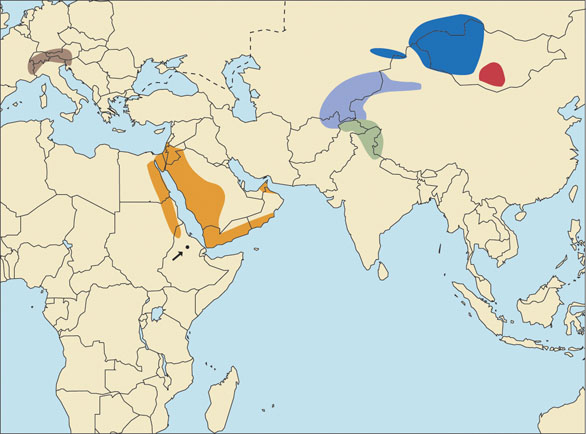 |
 |
Capra sibirica sibirica
Ibice Siberiano (Sp), Sibirischer Steinbock (G), Bouquetin de Siberie (F).
DESCRIPTION (male) Shoulder height 37-42 inches (95-107 cm). Weight 175-220 pounds (80-100 kg), sometimes more. Females are much smaller.
A large ibex, thick-legged and stoutly built, with a long, pointed chin beard and heavy, scimitar-shaped horns. The summer coat is short, becoming long, coarse and brittle in winter with a dorsal crest and thick undercoat. Color is variable, but generally in summer it is some shade of yellowish or grayish-brown with a darker dorsal stripe, dark underparts and legs, and without a lighter saddle patch. Winter coat is yellowish-white and usually there is a large, light saddle patch. The dorsal stripe, tail and beard are blackish-brown. The male's horns are large and impressive, curving around to form three-fourths of a circle and tapering to relatively slender points. Horns are relatively flat on the front surface and have well-defined cross ridges. Females grow short, thin horns and lack beards.
BEHAVIOR Gregarious, living in herds of 40-50, sometimes more. Older males are often solitary or in small groups of 3-4, frequently in more inaccessible terrain. A grazer. Eyesight and sense of smell are excellent.
HABITAT Open, precipitous terrain at any altitude.
DISTRIBUTION Sayan and Altai mountains of Siberia and Mongolia.
Outside Asia, it has been introduced in the wild in New Mexico. Also found on private ranches in several parts of the world.
TAXONOMIC NOTES Includes altaica (Irtish Altai), fasciata (northeast Altai near Lake Telezko), lydekkeri (Katutay Range of Irtish Altai), sibirica (Sayan Mountains west of Lake Baikal) and typica (Tunkinskie Belki east of Irkutsk), with sibirica Pallas, 1776 having priority.
|





